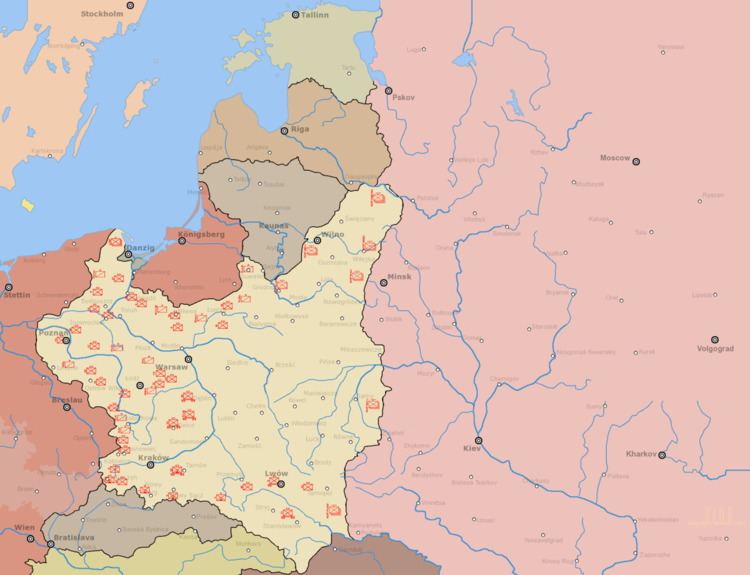 | ||
Polish OOB during the Invasion of Poland. In the late thirties Polish headquarters prepared "Plan Zachód" (Plan "West), a plan of mobilization of Polish Army in case of war with Germany. Earlier, the Poles did not regard the Germans as their main threat, priority was given to threat from the Soviets (see: Plan East).
Contents
- Karpaty Army
- Krakw Army
- Lublin Army
- d Army
- Modlin Army
- Pomorze Army
- Pozna Army
- Prusy Army
- Operational Group Wyszkw
- Independent Operational Group Narew
- Supporting forces
- References
The overall operational plan assumed the creation of 30 infantry divisions, 9 reserve divisions, 11 cavalry brigades, two motorized brigades, 3 mountain brigades and a number of smaller units. Most Polish forces were grouped into 6 armies and a number of corps-sized "Operational Groups". Later in the course of the war other operational units were created.
Karpaty Army
Created on July 11, 1939, under Major General Kazimierz Fabrycy. Armia Karpaty was created after Germany annexed Czechoslovakia and created a puppet state of Slovakia. The main aim of the army was to secure mountain passes in the Carpathians. Initially the army consisted of 2 improvised mountain brigades and a number of smaller units, but later in the course of war was joined by forces of the withdrawing Armia Kraków.
Additionally, mobilisation plans called for creation of the Tarnów Group consisting of:
Kraków Army
Created on March 23, 1939, as the main pivot of Polish defence. Its main task was to delay advancing German troops and withdraw eastwards along the northern line of the Carpathians. It consisted of 5 infantry divisions, 1 mountain brigade, 1 motorized cavalry brigade, 1 mountain brigade and 1 cavalry brigade under gen. Antoni Szylling.
Lublin Army
An improvised army created on September 4 from 1 motorized brigade and various smaller units concentrated around Lublin, Sandomierz and upper Vistula. Commanded by mj. gen. Tadeusz Piskor.
Łódź Army
Created on March 23, 1939, under gen. Juliusz Rómmel. Armia Łódź was to become a bolt between Armies "Kraków" and "Poznań". However, because of mistakes committed by Gen. Rómmel, the army was located too close to the German border and joined fighting from the very beginning of the campaign, which deprived it of any possibilities of cooperation with the surrounding units. It consisted of 4 infantry divisions and 2 cavalry brigades.
Modlin Army
Created on March 23, 1939, for defence of Warsaw from the north. The army was to defend fortified lines along the border with East Prussia near Mława, and then retreat towards Narew river. Led by brig. gen. Emil Krukowicz-Przedrzymirski. Consisted of 2 infantry divisions and 2 cavalry brigades.
Pomorze Army
The Army was created on March 23, 1939, to defend Toruń and Bydgoszcz and to carry out delaying actions in the so-called "Polish Corridor". It was led by Lt.-Gen. Władysław Bortnowski and consisted of five infantry divisions, two National Defence brigades and one cavalry brigade.
Poznań Army
The Armia Poznań led by mj. gen. Tadeusz Kutrzeba was to provide flanking operations in the Grand Poland and withdraw towards lines of defence along the Warta river. It consisted of 4 infantry divisions and 2 cavalry brigades.
Prusy Army
Under gen. Stefan Dąb-Biernacki. Created in the summer of 1939 as the main reserve of the Commander in Chief. According to the "Plan West" (Plan Zachód, code name for the Polish mobilization plan) it was to be composed of units mobilized as the second and third waves and its main purpose was to cooperate with the nearby armies "Poznań" and "Kraków".
Mobilized in two groups. Because of fast German advance both groups entered combat separately and most units did not reach full mobilization. It consisted of 6 infantry divisions, 1 cavalry brigade and a battalion of tanks.
Created on September 10, 1939, from various units in Warsaw and Modlin Fortress area. Initially it consisted of approximately 25 infantry battalions and 40 tanks. Later it was reinforced by forces of Łódź Army and elements of Modlin Army. It was commanded by col. Walerian Czuma, although the nominal commander was gen. Juliusz Rómmel.
Operational Group Wyszków
Was one of the reserves of the northern front of Polish defences, created on September 1, 1939. According to Plan West, it was supposed to defend the line of the Narew river from Wehrmacht units advancing from East Prussia. Due to rapid German advance, the group withdrew towards the Bug river, and on September 11, Polish Commander in Chief Edward Rydz-Śmigły ordered General Wincenty Kowalski, commandant of Operational Group Wyszków, to merge his unit with Northern Front under General Stefan Dąb-Biernacki.
It consisted of the following units:
Independent Operational Group Narew
Consisted of 2 infantry divisions and 2 cavalry brigades:
Supporting forces
Air support
Naval and river support
